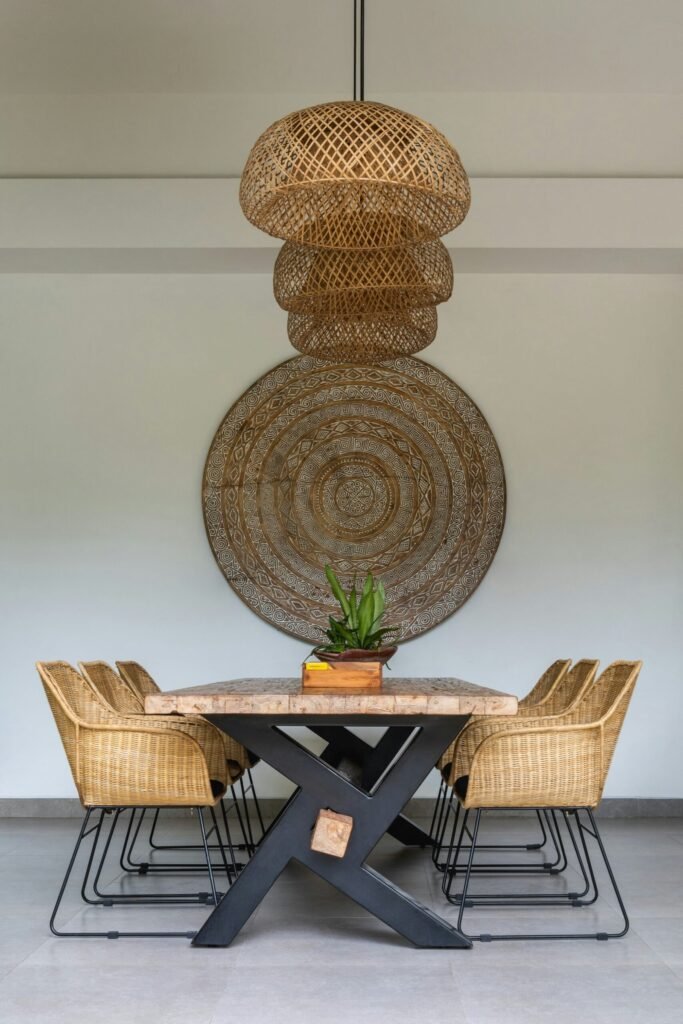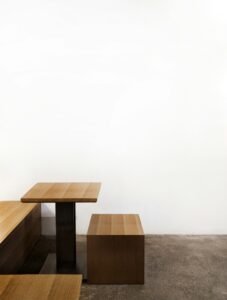
Introduction to Rattan Furniture Export
Rattan furniture has gained substantial acclaim in recent years, emerging as a preferred choice for both residential and commercial settings across the globe. Comprised from the rattan palm vine, this sustainable material offers a unique blend of durability, flexibility, and aesthetic appeal, making it an ideal candidate for stylish yet functional furniture. As consumers increasingly prioritize eco-friendly options, the popularity of rattan products continues to rise, demonstrating a growing commitment to sustainability in design.
The versatility of rattan enables the creation of a wide array of furniture items, including chairs, tables, and decorative accessories. Its lightweight properties allow for easy mobility, while the inherent strength of the material ensures longevity. This combination of characteristics has not only revolutionized the furniture industry but has also bolstered the demand for rattan furniture in international markets. As a result, understanding the intricacies of rattan furniture export has become increasingly important for suppliers and manufacturers eager to maintain a competitive edge.
Exporting rattan furniture requires knowledge of various procedures, including regulations, documentation, and compliance with international standards. Such an understanding helps mitigate risks, enhance product reach, and ensure that businesses are well-positioned to navigate the complexities involved in selling rattan products worldwide. Moreover, fostering relationships with international buyers and staying informed about market trends can significantly impact the success of rattan furniture exporters.
Acknowledging the advantages of rattan as a sustainable material serves not only to attract environmentally conscious consumers but also to inspire innovative designs within the furniture sector. As the world becomes more interconnected, the importance of exploring the dynamics of rattan furniture export will only continue to grow, making it a vital industry to understand and engage with.
Understanding Rattan: Characteristics and Types
Rattan is a versatile climbing palm that has gained immense popularity as a material for furniture due to its unique characteristics. Renowned for its durability, rattan is capable of withstanding significant wear and tear, making it an ideal choice for furniture that is utilized in both indoor and outdoor settings. Its natural resilience is accompanied by a flexibility that allows it to be crafted into an array of shapes and styles, which further enhances its aesthetic appeal. Rattan’s lightweight nature not only facilitates ease of movement but also provides an opportunity for designers to create intricate patterns and forms, ensuring it remains a sought-after option in the furniture market.
One of the standout features of rattan is its ability to be easily manipulated without sacrificing strength, allowing manufacturers to craft intricate and well-structured designs. This flexibility opens a wide range of creative possibilities, enabling the production of contemporary, traditional, and eclectic furniture styles. From chic lounges to rustic dining sets, rattan accommodates diverse tastes and preferences, catering to various market demands.
Rattan furniture can generally be categorized into indoor and outdoor products. Indoor rattan furniture often includes pieces like chairs, sofas, and tables, which typically feature cushions for added comfort. In contrast, outdoor rattan furniture is designed to withstand the elements, often made with synthetic rattan or treated for weather resistance. Understanding these distinctions is crucial for potential exporters aiming to target the right audience in their respective markets. Each type serves distinct purposes and attracts different consumer demographics, which can guide marketers in developing tailored strategies to effectively reach potential buyers.
Market Research: Identifying Export Opportunities
In the realm of rattan furniture export, conducting thorough market research is quintessential for identifying lucrative export opportunities. Understanding target markets is the cornerstone of successful commercialization, as it allows exporters to align their offerings with the specific needs and preferences of consumers in varying geographic locations.
First and foremost, defining target markets begins with analyzing demographic factors such as age, income levels, and lifestyle preferences of potential buyers. This insight aids businesses in tailoring their marketing strategies accordingly. Additionally, exporters should employ tools like surveys and focus groups to gather qualitative data on consumer preferences, helping to discern the types of rattan furniture designs, colors, and functionalities that are most appealing to prospective customers.
Competition analysis is another critical component of market research. By evaluating the performance and strategies of existing rattan furniture brands in the selected markets, exporters can identify gaps that their products could fill. Understanding the pricing strategies and customer service models of competitors can provide invaluable knowledge for positioning one’s own offerings. It is also essential to assess the economic factors at play in the target markets. Economic stability, disposable income levels, and trends in consumer spending can directly influence the demand for rattan furniture.
Geopolitical factors must also be considered, as trade agreements and tariffs can significantly affect export viability. By synthesizing all gathered information from demographic studies, consumer feedback, competition analysis, and economic trends, exporters can develop a strategic entry plan for their rattan furniture in chosen markets. Not only does this method streamline the decision-making process, but it also optimizes resource allocation, ultimately enhancing the likelihood of success in the competitive landscape of international furniture exportation.
Legal Regulations and Compliance for Exporting Rattan Furniture
Exporting rattan furniture necessitates a comprehensive understanding of various legal regulations and compliance requirements to ensure a smooth transition across international borders. The rattan industry, like many other sectors, is governed by both domestic laws of the exporting country and the import regulations of the target market. Thus, familiarity with these legal frameworks is essential for exporters.
One of the primary legal aspects involves obtaining the necessary certifications. For instance, certifications related to the sustainability and sourcing of rattan materials may be required, particularly given the increasing global emphasis on environmentally responsible practices. Additionally, compliance with specific trade regulations, such as the Convention on International Trade in Endangered Species (CITES), may be necessary if materials from endangered rattan species are used. Exporters should thoroughly investigate relevant environmental standards to ensure compliance.
Moreover, proper export documentation is critical in facilitating a seamless export process. Essential documents may include commercial invoices, packing lists, and bills of lading. These documents help confirm the details of the transaction and ensure that customs requirements are met in both the exporting and importing countries. A failure to provide adequate documentation can lead to delays, increased costs, and potential legal disputes. It is also advisable to check if specific export permits or licenses are required by the home country or the destination market.
Compliance with international trade laws, including tariffs and non-tariff barriers, is another important consideration for exporters. Each market may have different import duties, quotas, or restrictions, which can significantly impact the viability of exporting rattan furniture. By understanding and adhering to these regulations, exporters can mitigate the risk of legal complications and enhance their competitive advantage in the global market.
Sourcing and Manufacturing Rattan Furniture
The process of sourcing quality rattan materials is paramount for manufacturers aiming to produce competitive rattan furniture. Rattan, known for its durability and flexibility, is primarily sourced from tropical regions, with Southeast Asia being a significant hub. Ensuring that the rattan used is of high quality involves selecting suppliers who follow sustainable harvesting practices. This not only contributes to environmental conservation but also ensures a steady supply of premium materials for furniture production.
Once quality rattan is sourced, the manufacturing process begins. This typically includes several stages: harvesting, processing, weaving, and finishing. The initial stage involves skilled workers harvesting rattan from wild plantations and preparing it for further use. Processing involves stripping the rattan to remove its outer layer and cutting it into necessary lengths for furniture production. Craftsmanship plays a critical role at this stage, as experienced artisans weave the rattan into various forms and shapes, creating the desired design. The finishing stage often includes applying varnishes or other protective coatings to enhance durability and aesthetic appeal.
Selecting reliable suppliers and manufacturers is crucial in the rattan furniture industry. Conducting thorough research, including verifying certifications and examining past projects, allows for the assessment of a potential partner’s credibility. Furthermore, establishing clear communication regarding quality expectations, production timelines, and delivery schedules can help avoid misunderstandings and ensure compliance with international standards. Quality control measures should be integrated throughout the manufacturing process to identify defects and maintain the integrity of the final product. Overall, investing time in quality sourcing and manufacturing is essential for building a reputable brand in the rattan furniture market.
Packaging and Shipping Considerations
When it comes to exporting rattan furniture, effective packaging and shipping practices are paramount to ensure that items arrive at their destination intact. Rattan, being a natural material, is somewhat susceptible to damage during transportation due to its flexibility and light weight. To prevent such issues, proper packaging methods must be employed. One effective approach is to disassemble larger furniture pieces whenever feasible. For instance, separating seat cushions and legs from frames can reduce the risk of breakage and optimize space during shipping.
Utilizing high-quality protective materials, such as bubble wrap and foam padding, is essential. These materials should be strategically placed around the furniture to cushion against impacts. Additionally, using sturdy boxes that are specifically designed for heavy items can provide extra protection. It is advisable to use double-walled corrugated boxes to bear the additional weight of rattan furniture while preventing compression and damage.
Once packaged, selecting the right shipping options will play a critical role in cost management and delivery efficiency. Numerous carriers specialize in international shipping, each offering different rates and transit times. It is crucial to compare these services carefully. Choosing a logistics partner who understands the nuances of transporting rattan furniture can streamline the process and ensure compliance with international regulations. This includes understanding freight charges, which can vary widely based on the weight and dimensions of the shipment, as well as the destination.
Lastly, consider the complexities associated with customs clearance. Documentation, such as commercial invoices and packing lists, is vital for smooth transit. Ensuring all paperwork is accurate and complete can significantly alleviate delays and additional costs associated with international shipping. By adhering to these guidelines, exporters can mitigate risks and enhance the overall efficiency of their shipment processes.
Marketing Strategies for Rattan Furniture Export
In the competitive landscape of rattan furniture export, developing effective marketing strategies is essential for success. One of the foremost strategies is to build a robust online presence. Establishing a user-friendly website that showcases your rattan furniture collection with high-quality images and detailed descriptions will enhance visibility. Additionally, optimizing your website for search engines using relevant keywords related to rattan furniture will help attract organic traffic. Providing valuable content, such as blog posts and guides about the benefits of rattan furniture, can further engage potential customers and improve your site’s ranking.
Social media platforms like Instagram, Facebook, and Pinterest play a significant role in marketing rattan furniture. These visually-driven platforms allow exporters to showcase their products in innovative ways. Regularly posting attractive images of your products, sharing customer testimonials, and hosting giveaways can help in building a loyal customer base. Social media not only facilitates direct communication with customers but also enables exporters to leverage targeted advertisements, reaching specific demographics likely to be interested in rattan furniture.
Attending trade shows and exhibitions is another effective marketing strategy to promote rattan furniture. These events offer an excellent opportunity for exporters to network, showcase their products to a wider audience, and gather insights on market trends. Participants can also benefit from the chance to meet potential buyers and industry professionals who can enhance their market reach.
Lastly, forming partnerships with retailers can bolster the visibility of your rattan furniture. Collaborating with established brands or boutiques can facilitate access to a broader customer base. Retailers often have the infrastructure and market knowledge that can benefit exporters in navigating unfamiliar markets. By implementing these strategies—building an online presence, utilizing social media, attending trade shows, and leveraging partnerships—exporters can effectively promote their rattan furniture and reach international customers efficiently.
Sustainability and Ethical Considerations in Rattan Production
The increasing demand for rattan furniture has amplified the significance of sustainability and ethical considerations in its production. Rattan, a palm that thrives in tropical regions, is a renewable resource; however, unsustainable harvesting practices can lead to ecological imbalance. Therefore, it is imperative for manufacturers to engage in ethical sourcing of rattan, ensuring that the raw materials are harvested responsibly. This involves obtaining rattan from managed forests where replanting initiatives are in place, thereby preventing deforestation and promoting biodiversity.
Environmental impact is a crucial aspect of rattan furniture production. Ideally, the production process should involve minimal waste and use eco-friendly methods. For instance, water-based finishes and non-toxic adhesives should be utilized to reduce pollution. In addition, integrating energy-efficient tools and machinery can lower carbon emissions associated with furniture manufacturing. Ethical producers recognize that protecting the environment is not just a responsibility but an opportunity to differentiate their products in a saturated market.
Moreover, fair trade practices play a significant role in fostering sustainable rattan production. By ensuring that artisans and laborers are compensated fairly, manufacturers can foster community development and reduce poverty in rattan-producing regions. Consumers are increasingly driven by the desire to support brands that prioritize ethical standards, making fair trade an attractive component of supply chain practices. Aligning with sustainability values not only enhances a brand’s reputation but also appeals to a growing demographic of eco-conscious consumers who make informed purchasing decisions.
Ultimately, embracing sustainability and ethical considerations in rattan furniture production can lead to long-term benefits for both the environment and the businesses involved. As consumers become more aware of their impact on the planet, crafting a narrative surrounding ethical sourcing and environmental stewardship will be essential for brands aiming to thrive in today’s competitive marketplace.
Future Trends in the Rattan Furniture Export Market
The rattan furniture export market is poised for significant transformation as emerging trends and innovations shape consumer preferences and industry practices. One of the most notable trends is the growing demand for sustainable and eco-friendly products. Modern consumers are increasingly concerned about the environmental impact of their purchases, prompting manufacturers to explore sustainable sourcing and production practices. Upcycling and the use of renewable resources are becoming prominent strategies within the rattan industry, allowing exporters to cater to eco-conscious consumers while enhancing their marketability.
Additionally, the influence of digital commerce cannot be overlooked. The rise of e-commerce platforms has revolutionized the way consumers shop for rattan furniture. Exporters are leveraging online marketplaces to reach a global audience, making it essential to maintain a strong online presence. Social media channels and influencer marketing have become instrumental in promoting rattan furniture collections, enabling brands to connect with their target demographic more effectively. The shift towards online transactions is expected to continue, highlighting the necessity for rattan furniture exporters to invest in digital marketing strategies and user-friendly e-commerce platforms to remain competitive.
Advancements in production technologies are also driving change in the rattan furniture industry. Innovations such as automation and computer-aided design (CAD) are enhancing efficiency, reducing production costs, and allowing for greater customization of products. Automation in manufacturing processes not only streamlines production but also aids in maintaining consistent quality, a critical factor for exporters aiming for international markets.
In conclusion, the future of the rattan furniture export market will be shaped by the intersection of consumer preferences, digital innovations, and technological advancements. To thrive in this dynamic landscape, exporters must stay abreast of these trends and adapt proactively to the evolving marketplace.









